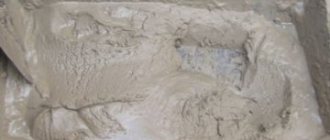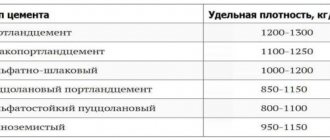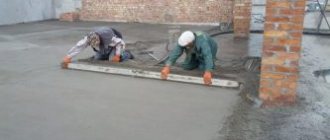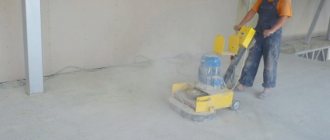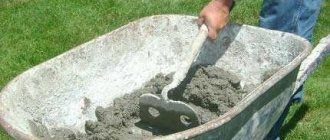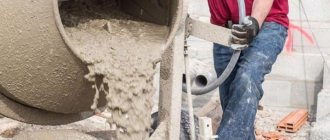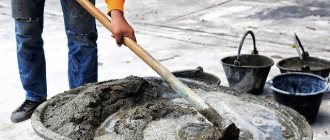In order for the cement and sand mortar to be reliable, you should know that for various construction purposes the mortar also differs in its composition and mixing proportions. The most common proportion is 1:3, where for 1 kilogram of cement there are 3 kilograms of sand. This proportion is used most often for brickwork and so on. But, for truly high-quality work, when making a solution it is necessary to take into account multiple factors, such as:
- Brand of cement what cement is used
- Type of sand: river, quarry, etc.
- The presence of other components in the solution besides cement, sand and water, modern fillers can be used
- For what kind of work is the mixture made: brickwork, plastering, pouring the foundation, making concrete products, etc.
Let's start with cement
Cement is the main component in almost any solution. There are a lot of cement manufacturers and suppliers on the market. Therefore, the ability to distinguish good cement from bad is very useful. To do this, you just need to remember the rule: the strength of cement can be determined by color; the stronger it is, the darker the shade.
It is better to take river sand, since its characteristics are ideal for preparing any solution. Before use, the sand should be thoroughly sifted to obtain a homogeneous mass.
Depending on the type of work performed, crushed stone, as well as special impurities, can be added to the solution. When using additional admixtures, you must study the instructions for their use. It can be found on the packaging; as a rule, manufacturers indicate on their products the purpose of a particular impurity, as well as the proportions of its use. Crushed stone is added when pouring the foundation, and it is important to pay attention to the crushed stone fraction - in simple terms, the size of the sieve cells through which the crushed stone is sifted.
For brickwork, cement is mixed with sand in a ratio of 1:4. You can also use a proportion of 1 to 3. Here you need to take into account the quality of the cement. Plastering work is also the most important stage in construction. The solution for such work is made in a ratio of 1:5. There is also lime-cement mortar. To prepare it, the same amount of cement and sand is used, but lime is dissolved in water. If you plaster the surface with such a solution, then it must be covered with something, since lime dries very quickly, thereby violating the uniformity and integrity of the plastered coating. In addition to sand and cement, crushed stone is used to fill the foundation. The proportion of the solution is as follows: 1:3:5, where 1 is cement, 3 is sand, 5 is crushed stone. This proportion for the foundation applies everywhere. At the same time, the quality of the cement should be higher than the “M-300” grade.
How to dilute the mixture for masonry
To prepare it, you need to know the required proportions of the materials used, as well as the sequence of their mixing. For the simplest non-dry mortar, you need to prepare water, sand, cement, and detergent. It is better to mix it in a concrete mixer. This helps produce a more homogeneous mixture. Water is poured in first, its quantity depends on the quality of the building ingredients used.
Weather conditions also affect the amount of water. So, you need to take less of it if the sand is wet or it’s humid outside. The amount of water on average is approximately equal to the amount of cement, although it is better to pour less and add more if necessary. When adding all the ingredients, you need enough water to mix the mixture evenly. If there is a lot of water at the initial stage, the cement will become liquid and spreading. If there is a lack of it, it will be thick and unmixed.
It is best to dilute it this way: first pour in enough water so that the cement is well mixed, and when the mass is homogeneous, adjust the thickness by adding the mixture or water in small portions.
Add 50-100 grams of liquid soap or detergent to the mixer after water before adding sand and cement to increase the elasticity of the solution.
It is necessary that it dissolves completely in water and forms foam. This will take 3-5 minutes. It is not recommended to dilute the product in the mixture at the very end, since it will not completely dissolve and will be distributed unevenly throughout the volume.
Next, you need to pour half the required amount of sand, for example, if you are preparing a product with a ratio of 1:4, then take 2 cubes of sand for 1 cubic meter of cement. Then the second half of the building material is filled in. Next, you need to check the thickness of the solution and, if necessary, adjust it by adding mixture or water.
The concrete will be ready in 3-5 minutes. A high-quality mixture for the foundation should not be liquid or very thick; when you run your finger over it, the mark should not be blurry, but clear. This is easy to do and will take about 20 minutes.
To obtain a high-quality result when constructing any type of structure, it is necessary to comply with the requirements appropriate for each type of work. So, when laying the foundation of a building, erecting walls, and so on, different types of mortars are used, the execution process for each of which is different. Without knowing how to dilute cement to obtain the composition of the required concentration, it is impossible to be confident in the successful result of the work performed.
Types of building compounds
Before answering the question: “How to dilute cement?” — Let’s look at what mortars this material is used in. Conventionally, the following types of compositions can be distinguished:
- Concrete solution. This type is used in such works as laying various structures, screeding floors and others. Therefore, it is recommended to use higher grades of cement here. It can also be noted that such types of raw materials as Portland slag cement, aluminous material and others are often used for these purposes.
- Cement-lime composition. This can be used for various purposes (for jointing, plastering, for “spraying” and others). Note that you need to know how to dilute cement, the proportions of substances and preparation for each case, since these points may vary.
- Masonry composition.
Methods for preparing solutions
Let's look at how to dilute cement for various compositions. As noted above, concrete mortar is used for the foundation. The preparation of this composition may depend on many factors, such as the season of the year (when the building is being erected), the conditions of the region (terrain) and others. In this case, various additives can be used (plasticizers, modifying admixtures, and others), which significantly increase the characteristics of concrete, reduce the “setting” time, prevent the appearance of cracks, and so on. However, we can highlight the main points that apply to all types of concrete compositions. Also, to know how to dilute cement for a foundation, the following information will be useful:
- All solutions have a constant composition - cement, sand (it is recommended to use the quarry type), gravel (crushed stone) and water.
- The ratio of fillers is adjusted depending on the type of binder element, that is, the higher, the denser the consistency of the solution. So, for 1 m 3 of sand, the consumption of this material will be as follows: M150 - 230 kg, M200 - 185 kg, M300 - 120 kg, M400 - 90 kg. Also, the ratio differs depending on the type and For manual masonry, the mortar can be mixed by taking the ingredients in the following proportions (expressed in parts): cement (1), sand (3.5), gravel (crushed stone, 5) and water (1/2). In this case, concrete grade 50 is obtained.
- Water should not contain impurities such as oil, chlorine-containing compounds, residues of other solutions, etc.
- The quality of the solution will be better if the mixing is done in a concrete mixer.
The cement-lime composition is also prepared in different proportions depending on the place of use. For example, to perform plastering in areas of greater wear, passages, etc.), you need to increase the consumption of binder material. However, a single procedure can be identified, the main points of which are as follows:
- “Quench” the lime with water in a separate container in advance.
- Mix sand and cement.
- Dilute the mixture in lime milk.
The ratio of substances depending on the work:
- for finishing walls and ceilings - cement (60 kg), lime (140 kg);
- for work on flights of stairs - cement (100 kg) and lime (140 kg);
- for plastering on a grid - cement (50 kg), lime (140 kg) and sand (1 m3).
The masonry mortar can be prepared as follows:
- Mix sand and cement (3:1) so that a homogeneous mass is obtained.
- Mix with water, the amount of which depends on the degree of moisture of the sand. You can determine it visually by gradually adding it to the container and stirring. The solution should be plastic and not lag behind the spatula.
- The composition must be used within 2 hours.
Knowing how to dilute cement for various mortars, you can correctly select the ratio of constituent substances and mixing conditions. At the same time, it is possible to significantly improve the quality of work in which these compounds are used.
Cement is a popular building material used in the process of performing various works. It produces concrete used in the construction or repair of structures, when creating foundations or other objects. It is cement that is the main component for the formation of concrete mortar. Therefore, you need to know exactly how to properly create this mixture so that it has the desired consistency and homogeneity. So, let's look at how to properly dilute cement.
Important!
The quality and other parameters of the concrete solution determine the strength, reliability, service life and resistance of the resulting structures to various influences.
Water is also an important main component of any solution.
There are special tables for calculating the proportions of water consumption in a solution. But practice shows something else: every builder prefers to add water himself, since the consistency of the solution required is different, somewhere thicker, somewhere thinner. But in concrete production plants, each component is added strictly in certain proportions, based on this, concrete of different markings and different purposes is obtained.
A little construction trick. When preparing the solution manually in a special container, first of all, sand and cement are poured in the required proportion, then water is added, then it is all mixed. The trick is this: after adding water, you need to wait 10-15 minutes and only then stir. During this time, the water will be completely absorbed into the mixture of cement and sand, the resulting mass is very easy to mix, a few stirrings are enough. If you stir the mixture immediately after adding water, you will have to work hard.
If you do not have a special container at hand, then the solution can be kneaded without it; for this, the following method is used. Sand and cement in the required proportions are poured into one heap on a flat surface, the resulting mass is thoroughly mixed. Then, using shovels, a hole is made in the middle of the pile into which water is poured. After this, starting from the edges, the dry mixture is carefully poured into the water. So, gradually, a solution is obtained; if necessary, you can add water.
How to prepare the solution?
Cement
I would like to immediately note that cement, as a means of bonding, is used exclusively as solutions and mixtures that determine the following nuances:
- brand of cement;
- “origin” of water (from the water supply, rain or melted snow);
- what filler is added (crushed stone, sand, slag or sawdust);
- area of use of the substance (brick laying, plastering, foundation creation).
You can dilute cement and combine the necessary ingredients either in a plastic container or in a metal container. For these purposes you can use:
- buckets;
- basins;
- old cast iron bathtub;
- strikers made of wood.
The cement-sand mixture is prepared as follows:
- sift sand through a sieve;
- combine cement with sand and mix the substance until smooth;
- gradually add water a little at a time;
- knead the mixture until smooth, so that the mass resembles sour cream in thickness.
To understand that the mixture is mixed according to all the rules and its consistency has the necessary viscosity, you need to do some manipulations. To do this, the mass is applied to the surface of a trowel or spatula and turned over with the solution facing down. If the substance does not flow down, but remains on the surface of the instrument, the solution is prepared correctly.
Related article: Do-it-yourself foundation made of FBS blocks
Pay attention to how long it takes for the cement to dry. The finished solution must be used within a maximum of 90 minutes.
Cement marking
To better understand concrete production technology, you should familiarize yourself with the markings of cement. For example, cement M400-D20. The number 400 represents the percentage of flexural strength and 20 represents the percentage of additives used in the cement. That is, cement with this marking has a tensile strength of 400 kilograms per 1 cubic centimeter.
If the marking of cement is known, then you can easily calculate the marking of the mortar obtained from this cement. Take, for example, cement M400. If you mix it with sand in a ratio of 1:4, you get a solution of M100 400/4. And if you mix the same cement in a ratio of 1 to 2, then the brand of mortar will be M200. It is important to remember that temperature has a huge impact on the quality of the solution. If it is cold outside, or even winter, then the cement mortar does not have time to fully set, the water turns into ice, because of this, cracks appear, the mortar itself becomes brittle and crumbles easily. Therefore, when working with cement mortar in the winter, special devices, anti-frost additives, electric steam generators, and so on are used. This is done in order to maintain the strength and quality of the resulting solution.
Also, do not forget that you cannot leave the prepared solution for a long time without stirring. Such a solution, even if you fill it with water, will set, resulting in a mass with reduced tenacity properties. It cannot be used in construction work. Therefore, when working, it is always necessary to periodically mix the concrete so that it retains its adhesive functions.
Summarizing the above, we can draw the following conclusions:
- The proportions of cement and sand are an important component of the mortar preparation process that cannot be ignored.
- To prepare the solution, you should know what brand of cement will be used
- For what types of construction work is the solution made?
- For the foundation use cement, sand, crushed stone in a ratio of 1: 3: 5
- For plastering work use cement and sand in a ratio of 1:5
- For brickwork, use a ratio of 1:3, 1:4, depending on the quality of the cement
- When working with cement mortar, pay attention to weather conditions. Very cold is bad, very hot is also bad.
- When using various additives, carefully study the instructions for their use, pay attention to the specified mixing proportions of this additive and cement mortar
- When purchasing cement, pay attention to the markings and color. Dark cement is always better in quality.
These are the main points for preparing cement mortar. During any construction, all characteristics should be taken into account so that the final result meets the standards. The wrong proportion of cement and sand, as a result of unscrupulous and poorly controlled use, can lead to accidents and even death. Therefore, you always need to follow the concrete manufacturing technology, know the process of the work being performed, and correctly calculate the load on a particular element. Only if these rules are observed can you get to work.
In what proportions should cement be diluted?
The correct proportions can vary significantly between different mixtures. Therefore, before mixing, it is necessary to decide for what purposes a particular solution will be used.
Important!
The consistency of the solution changes depending on the proportions of the components.
The most popular mortars that require cement are:
- Mixture for plastering walls.
To prepare it, it is recommended to use 1 part cement and 3 parts sand. The volume of water is usually equal to part of the cement, but it cannot be added immediately, so it is poured into the dry mixture in small portions to obtain the desired consistency. If you need to carry out internal plastering work, then the M150 or M200 grades are selected, and if you plan to plaster the facade, then the M300 grade is suitable. - Brick masonry mortar.
Here we use 1 part cement and 4 parts sand. The optimal brands for this work are considered to be M300 and M400. Often slaked lime is added to this mixture, acting as a binder. Its amount is calculated as 0.2 parts per 1 part cement. This substance produces a plastic solution, which is quite easy and convenient to work with. The amount of water may vary, as it is added gradually until a solution of the desired density is obtained. It is important to make a mixture that will not flow from the spatula, tilted at an angle of 40 degrees.
- A mixture designed to create a floor screed.
Typically the following proportions are used: 1 part cement to three parts sand. The M400 brand is considered optimal. Water is added in a volume of ½ the amount of cement. To make a rare solution, it is recommended to gradually add water, as it is important that the mixture stretches well, which ensures that all voids in the base are filled. - Concrete.
To create concrete, use 1 part cement, 2 parts sand and 4 parts gravel. If this solution is made to form the foundation of a building, then it is necessary to purchase material grade M500. The amount of water is equal to ½ of the cement. The water must be clean and potable, and it is recommended to stir the composition with a concrete mixer (how to choose a concrete mixer for your home and garden). The entire solution must be used within an hour after receiving it.
Important!
If you want to get a mixture in sufficient quantity to form the foundation of a building, then you will need a fairly large amount of it, for which special equipment is used, represented by a concrete mixer.
Often, ready-made solutions are purchased at the factory, and in this case you need to make sure that the mixture is created immediately before sending it to the customer. Before purchasing, we study all the documents for the mixture in order to know what components it consists of, as well as what parameters it has.
It is necessary to choose the right grades of material to form different solutions. If the mixture is intended to create brickwork, then you can use grades M50 or M100, and if you need to make a foundation, then it is advisable to choose grades from M300 to M500. The higher the grade of material, the more durable and reliable the solution will be.
Is it possible to “paint” the cement paste?
We dilute cement ourselves
Cement floors or walls are not a very attractive sight. But even such an unsightly mass can be easily transformed with the help of special means.
To add color to the gray mass, you can use:
- dry powders;
- concentrated paste;
- emulsion;
- microcapsules.
How to dilute such funds? In order for the cement dye to fulfill its “mission”, it will be enough to mix it into the finished solution, after which the result is a substance with the most durable color, which does not lose its brightness for many years.
Related article: How to make a septic tank without pumping for a summer residence
This cement paint is widely used in the production of paving slabs, natural tiles or paving stones.
The pigment for cement must meet the following requirements:
- not lose its color for many years;
- do not succumb to the influence of water (i.e. do not wash off or dissolve under its influence);
- Resistant to alkali exposure;
- do not fade from exposure to sunlight.
As you can see, there is nothing complicated in coloring and mixing cement, but you can get the desired shade: from the usual gray to pink, blue, yellow or green.
